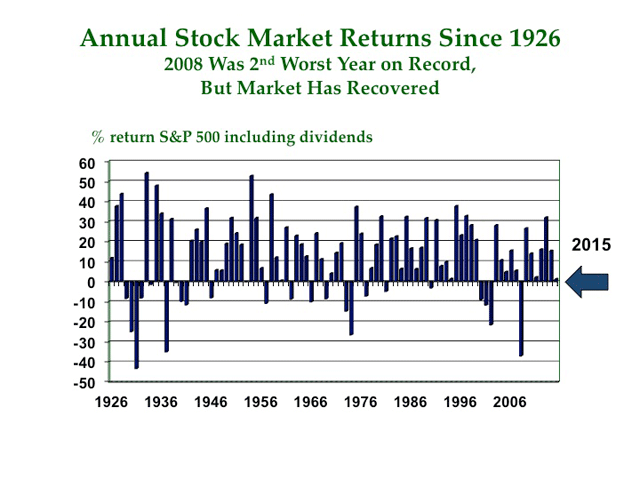Not everyone lost money on the S&P 500 last year
How much did the S&P 500 return in 2015? It was hard to miss the reports that pointed out the 0.7 percent loss in value for this benchmark index. But that's not the whole truth. If you're a buy-and-hold investor, you came out ahead -- to the tune of 1.2 percent for 2015, the seventh straight calendar year of positive returns since the crash of 2008-09.
Confused? The reason for the difference is that the index measures only the value of the stocks in the S&P 500 and doesn't include returns from dividends on these stocks. But this metric doesn't make sense when assessing your portfolio's investment returns because your total return comes from both appreciation and dividends.
So, rather than breaking a multiyear streak of positive returns, that streak is now getting closer to its nine-year run of positive returns, from 1991 to 1999, the longest since 1926 (chart below).
When a mutual fund compares its return to the change in the S&P 500 index, it's really giving itself an unfair advantage by excluding the returns on dividends paid by S&P 500 stocks.
You'll also see slight differences between the S&P total return and the returns on popular index mutual funds. For example, Vanguard's lowest-cost S&P 500 index fund, Admiral Shares, returned a positive 1.36 percent during 2015, and its Investor Shares fund earned 1.25 percent (Investor Shares has higher fees but a lower minimum investment than Admiral Shares).
This difference in percentage points illustrates two important facts: Index mutual funds may not exactly track the return on the underlying index, and fees can make a difference.
The above chart does a good job of showing the benefit of investing in stocks for the long term. For instance, you'll see about twice as many years with positive returns than years with losses.
But that's not all. Look more closely, and you'll see the up years return about twice as much as the amount of losses in the down years.
If you stay invested and if history repeats itself, the up years will overcome your losses during the down years. But be careful: Chances are very good more down years are in our future.
As a result, you'll want to develop strategies now that enable you to stay invested and ride out future stock market drops. The hefty market decline on 2016's first trading day is a good reminder of the need for such a strategy.
If you're several years away from retirement, you can use this information to give yourself the confidence to remain invested during the down years. If you're close to retirement, or already retired and drawing on your retirement savings, you'll want to devise strategies to protect a portion of your retirement income from market downturns.
One such strategy would be to piece together sources of retirement income that don't drop when the market declines and that cover your basic living expenses. Examples include Social Security, a pension (if you have one), bond ladders or an annuity from an insurance company.
Develop a retirement investing strategy that enables you to survive future stock market declines, which are inevitable. Then go enjoy your life.

